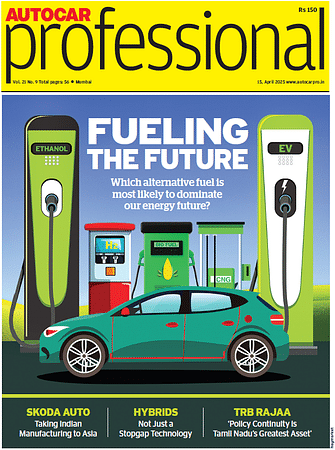Mahindra Surges in EV Market as New Models Drive Growth
The Mumbai-based company's share in EV car market has tripled in one year due to the launch of BE 6 and XEV 9e.
Mahindra & Mahindra has emerged as the biggest gainer in India's electric passenger vehicle market, with its market share jumping an impressive 1,046 basis points to reach 15.8% in March 2025, according to the latest BNP Paribas research report on India's electric vehicle industry.
The dramatic growth, which positions Mahindra as a serious challenger in the increasingly competitive EV space, has been primarily fueled by strong sales of its recently launched battery electric vehicles (BEVs) – the XEV 9e and BE 6e models. These new offerings, despite their Rs 20 lakh-plus price tags, seem to have appealed to consumers looking for larger, full-featured EVs with an extended driving range.
The XEV 9e, a sophisticated SUV-coupe, starts at ₹21.90 lakh (ex-showroom) for its base Pack One variant with a 59 kWh battery, delivering an impressive 542 km MIDC range. The top-spec Pack Three variant, equipped with a larger 79 kWh battery, is priced at ₹30.50 lakh and boasts a substantial 656 km range with 286 bhp. Meanwhile, the more compact and sporty BE 6 begins at a more accessible ₹18.90 lakh for the Pack One variant with the same 59 kWh battery, while the high-end Pack Three variant reaches ₹26.90 lakh with the 79 kWh battery delivering a class-leading 683 km range.
The manufacturer's rapid ascent is particularly notable given its relatively modest 5.3% market share in February 2025, indicating that its new models have quickly gained traction with consumers despite their premium positioning.
Both models are built on Mahindra's INGLO platform and feature advanced technology, including LFP battery packs that can charge from 20-80% in just 20 minutes with a 175 kW DC charger. The XEV 9e stands out with its luxurious triple-screen dashboard (three 12.3-inch displays) and Level 2+ ADAS, while the BE 6 offers impressive performance credentials with 0-100 kmph acceleration in just 6.7 seconds.
Mahindra's performance represents one of the most significant month-on-month market share gains in the Indian EV sector's history, demonstrating that established automakers can successfully challenge early market entrants when they bring compelling products to market.
Overall, the electric passenger vehicle segment in India continues to grow, with sales volumes increasing approximately 10% year-over-year and 15% month-on-month in March 2025. Electric vehicle penetration in passenger vehicles improved to 2.9% in March, up from 2.5% in February.
JSW MG Motor
Despite Mahindra's gains coming partly at its expense, JSW MG Motor continues to be a formidable player in India's electric vehicle landscape, holding a 31.6% market share in March 2025. Though this represents a significant drop of 521 basis points from its February position (36.8%), the company remains solidly in second place in the electric passenger vehicle segment.
The joint venture between China's SAIC Motor and Indian conglomerate JSW Group has achieved a remarkable transformation in its market position. Before August-September 2024, JSW MG Motor barely registered in India's EV market share statistics. The introduction of its Windsor EV and, more significantly, its innovative Battery-as-a-Service (BaaS) model has dramatically altered the company's trajectory in the Indian market.
The pricing innovation through BaaS has been revolutionary for JSW MG Motor's market penetration. Under this model, the MG Windsor EV, an intelligent crossover utility vehicle (CUV) with a 38 kWh battery offering a 331 km range, starts at just ₹9.99 lakh (ex-showroom) without the battery, with customers paying a usage-based battery rental of ₹3.5 per kilometer. The compact urban MG Comet EV is available at an even more accessible ₹4.99 lakh, with a battery rental of ₹2.5 per kilometer, offering a 230 km range from its 17.3 kWh battery. For premium buyers, the MG ZS EV begins at ₹13.99 lakh with a ₹4.5/km battery rental, providing a 461 km range from its 50.3 kWh battery.
The BaaS approach, which allows customers to purchase vehicles without batteries and instead pay a subscription fee for battery usage, has addressed one of the key barriers to EV adoption in India: high upfront costs. By reducing initial purchase prices and shifting battery costs to an operational expense (with a minimum commitment of 1,500 km/month), JSW MG Motor has successfully expanded its customer base beyond traditional early adopters.
According to the BNP Paribas report, MG's slight retreat in market share follows a period of substantial growth and comes amid intensifying competition from both domestic and international players. The company's bold business model innovation with BaaS and its focus on feature-rich offerings with competitive range specifications have built a loyal customer base that continues to support its strong market position.
Industry analysts note that JSW MG Motor's strategic focus on affordable EVs through innovative financing has helped democratize electric vehicles in India. The company's partnerships with Vidyut and Bajaj Finance to support the BaaS initiative have created a compelling ecosystem that reduces running costs by approximately 40% compared to traditional ICE vehicles.
As the market becomes more crowded with new entrants, JSW MG Motor is expected to face increased pressure to maintain its market share, but its established brand recognition in the EV space and innovative business models provide competitive advantages that newer entrants will struggle to overcome quickly. With an ambitious target of deriving over 50% of its sales from EVs in 2025, the company remains firmly committed to leading India's electric transition.
Tata Motors' EV Leadership
While Mahindra's gains and MG's resilience have captured attention, Tata Motors continues to lead India's electric passenger vehicle market, maintaining a dominant 38.3% share in March 2025. This represents a decline of approximately 430 basis points from the previous month but still places the company well ahead of its nearest competitors.
The BNP Paribas report indicates that Tata Motors' leadership position remains secure despite increasing competition, built on the foundation of its diverse electric vehicle portfolio that includes the Nexon EV, Punch EV, and Tiago EV. These models have helped the company address multiple price points and consumer segments, establishing Tata as the benchmark for domestic EV manufacturers.
Unlike JSW MG Motor, Tata Motors has publicly expressed its aversion to the Battery-as-a-Service (BaaS) model, with executives stating the company has no interest in carrying batteries on its own balance sheet. This strategic difference highlights the divergent approaches to EV adoption in the Indian market, with Tata focusing on outright ownership models and financing partnerships rather than subscription-based battery services. The company has emphasized that its financial structure and business model are not aligned with maintaining battery assets on its balance sheet, preferring instead to optimize its vehicle pricing and offer conventional financing options.
The company's commitment to electrification is reflected in its EV sales mix, with electric vehicles representing 10.4% of Tata's passenger vehicle sales in March 2025. Though this is a slight moderation from 11.1% in February, it remains significantly higher than most competitors and demonstrates the company's successful integration of EVs into its overall product strategy.
Looking ahead, Tata Motors has lined up additional EV launches to defend its market position, including the Harrier EV and Sierra EV planned for later in 2025, followed by the Avianya in 2026. This aggressive product roadmap signals the company's determination to maintain its leadership as competition intensifies.
The shifting market shares among the top three players – Tata Motors, JSW MG Motor, and Mahindra – highlight the dynamic nature of India's evolving electric vehicle landscape. As consumer preferences mature and more manufacturers enter the space, the BNP Paribas report suggests that product innovation, price competitiveness, and charging infrastructure development will become increasingly critical differentiators in determining market leadership.
India's overall EV penetration continues to grow across segments, with the three-wheeler sector leading at 59.3% electrification, followed by two-wheelers at 8.6% and passenger vehicles at 2.9% in March 2025. With multiple new product launches planned across manufacturers for 2025, the competition for market share is expected to intensify further.
RELATED ARTICLES
Apollo Tyres To Cease Production At Enschede Plant Amid Rising Costs And Market Shifts
Indian manufacturer plans to wind down the Netherlands operations by summer 2026.
Ather Energy Raises Rs 1,340 Crore from Anchor Investors ahead of IPO
SBI Mutual Fund schemes picked up around 23.1% of the total shares purchased by anchor investors, while Aditya Birla Sun...
Maruti Suzuki to Equip All Cars with Six Airbags This Year, Says Chairman Bhargava
"From a safety point of view, the government was very keen that six airbags should be in all cars. We will implement thi...






 03 Apr 2025
03 Apr 2025
 2672 Views
2672 Views





 Shahkar Abidi
Shahkar Abidi


 Shruti Shiraguppi
Shruti Shiraguppi

 Prerna Lidhoo
Prerna Lidhoo

